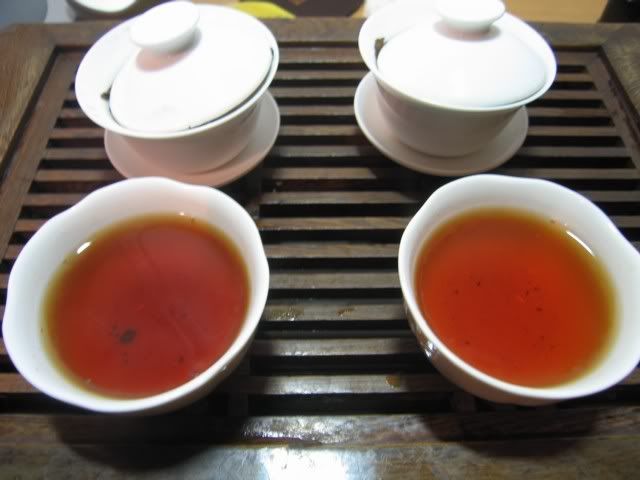People who read this blog probably have all spent at least some time worrying about storage conditions for their puerh tea. There are lots of people who have written lots of things on this subject. Some are plain wrong. Others more plausible. At the end of the day though, there isn’t much hard data to go by, so it all ends up being a bit of a “he said, she said” sort of thing out there.
So it is a bit of a good fortune that I am now in possession of two cakes from the same batch that have been stored separately for over 10 years to compare. The cake in question is the Mengku Yuanyexiang (YYX). It gained fame originally because some people hyped it up around 2005/6 through the puerh magazines and online forums. The tea was produced by the Shuangjiang Mengku Rongshi factory, and exists in a thin and a thick paper version, with the thin paper version being naturally stored while the thick paper is traditionally stored. There was only one batch of each ever made, and while prices shot up when it became famous, the tea never really took off after that and is currently still on sale at places like Taobao for about $250 USD, although there seems to be only a few cakes left. Honestly, at that price it’s not really worth it, especially if the seller is an unknown quantity.
The cakes here in question come from two sources. One is mine – I bought mine from Taobao many years ago for something like $30 USD. The other cake is from a good old friend Phyll, who is an active photographer based in LA and who used to, many years ago, run the tea blog Phyll’s blog. He even has a tasting note for the YYXÂ here. He bought it from Guang of Houde when they used to sell this tea. We have each acquired our cakes about 9-10 years ago, and have stored them since.
My storage is quite simple – it has always lived in Hong Kong since about 2007, in a normal environment, no extra humidity, no climate control, nothing more than just “leave it out there and let it age”. It’s mostly lived in closed shelves/boxes, but not air-tight ones. Phyll, on the other hand, has mostly stored his tea in his off-site wine storage unit with a permanent 15 degrees celcius temperature and a constant 75% RH. So while he lives in LA, this is not LA storage but really a controlled climate storage.
So about a month or so ago we decided to swap teas – we traded cakes, basically, since we each have more than one. I take my photos, usually, but since he’s a professional with much better equipment, this is what the teas look like.
A is his, B is mine. There are a few things to notice here – mine is shinier, and it’s not an optical illusion or lighting problem. It really is. The brown is slightly darker/browner on mine as well, while his has a slightly greener undertone to the leaves. The paper on mine is more torn up, but that’s really just because the paper is extremely thin and tears up with any movement – and I’ve moved the tea a couple times. Aside from that, there’s no obvious difference. They smell a bit different, but that’s to be expected.
I actually have not tasted the teas yet. I have been holding on to the tea, trying to get it acclimated to Hong Kong before drinking. Sometimes air travel and what not can change things in the taste of a cake. I also just haven’t had the opportunity to really sit down and drink teas side by side. I hope to do so in the near future, so stay tuned.


















 RSS - Posts
RSS - Posts
I took you at your suggestion and have been reading some of your old post-Covid posts. I haven’t been to…